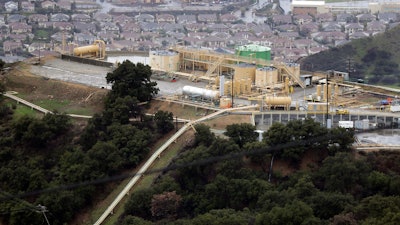
LOS ANGELES (AP) — California regulators voted Thursday to increase the capacity of a Los Angeles-area natural gas storage field where a 2015 blowout caused the nation’s largest-ever methane leak and forced thousands from their homes.
The California Public Utilities Commission voted unanimously to increase the storage capacity of the underground Aliso Canyon field to 41 billion cubic feet (1.1 billion cubic meters) of natural gas from the current capacity of 34 billion cubic feet (962 million cubic meters).
The move is aimed at ensuring supplies of natural gas for the upcoming winter months “in a safe and reliable manner" even as the PUC continues working on longer-term plans to close the field, Commissioner Martha Guzman Aceves said in a statement.
Neighbors and activists who want Aliso Canyon permanently closed said the increase was unnecessary and had urged the PUC to reject it.
The field, which stores gas in old wells, has been at 50% capacity since 2018, but the PUC vote raises that to 60%. The PUC rejected an alternative plan to allow the field to operate at 100% capacity.
The commission regulates natural gas utilities, including Aliso Canyon's operator, Southern California Gas Co.
A well failure at the field on Oct. 23, 2015, led to the release of nearly 100,000 tons of methane and other substances into the air for nearly four months before it was controlled.
The blowout was blamed for sickening thousands of residents who moved out of homes near the San Fernando Valley to escape a sulfurous stench and maladies including headaches, nausea and nose bleeds.
Ahead of Thursday's vote, some told the commission that they still smell gas and one Porter Ranch resident said she was afraid to open her windows, the Los Angeles Daily News reported.
The PUC's decision was “in favor of fossil fuel interests, not the wellbeing of California ratepayers,” said a statement from Alexandra Nagy, California director of Food & Water Watch.
The move “is not only dangerous, it is needless" and will create a “disastrous glut on natural gas," Nagy said.
SoCalGas said Aliso Canyon and other storage facilities will play “a key and essential role" in delivering gas and keeping energy prices stable this winter, when prices are expect to rise nationwide and interstate pipeline repairs limit regional supplies.
SoCalGas spent more than $1 billion on the the blowout — with most going to temporarily relocate 8,000 families.
State regulators found SoCalGas failed to investigate previous well failures at the storage site and didn’t adequately assess its aging wells for disaster potential before the blowout.
Last month, SoCalGas and its parent company, Sempra Energy, agreed to pay up to $1.8 billion to settle lawsuits by 35,000 people. The agreement is subject to about 97% of plaintiffs accepting it and could be reduced if fewer agree.
The utility faced hundreds of lawsuits on behalf of 48,000 people.
SoCalGas previously reached a $120 million court settlement with the state attorney general and agreed to a $4 million settlement with Los Angeles County prosecutors after being convicted in Los Angeles Superior Court of failing to quickly report the leak to state authorities.






















